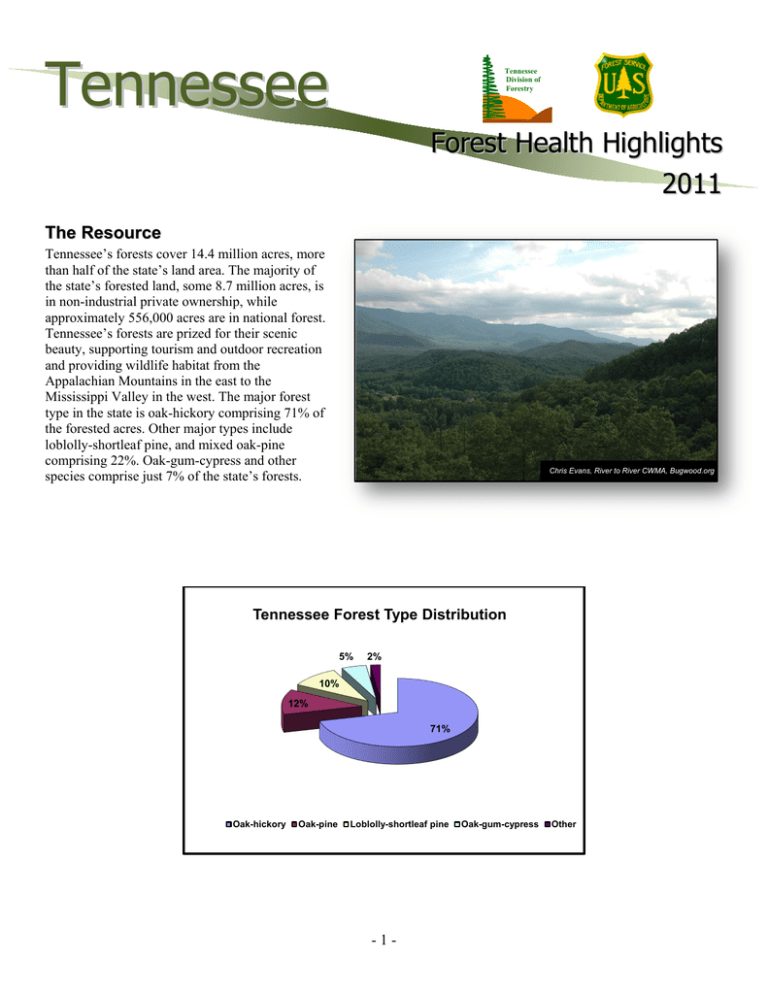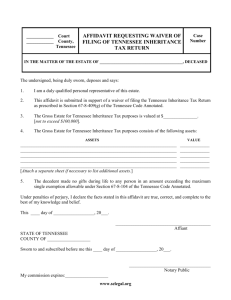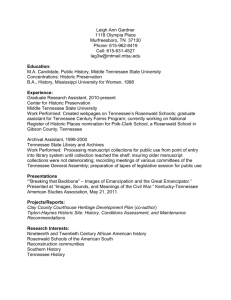T e n s
advertisement

Te nn e s s e e Tennessee Division of Forestry Forest Health Highlights 2011 The Resource Tennessee’s forests cover 14.4 million acres, more than half of the state’s land area. The majority of the state’s forested land, some 8.7 million acres, is in non-industrial private ownership, while approximately 556,000 acres are in national forest. Tennessee’s forests are prized for their scenic beauty, supporting tourism and outdoor recreation and providing wildlife habitat from the Appalachian Mountains in the east to the Mississippi Valley in the west. The major forest type in the state is oak-hickory comprising 71% of the forested acres. Other major types include loblolly-shortleaf pine, and mixed oak-pine comprising 22%. Oak-gum-cypress and other species comprise just 7% of the state’s forests. Chris Evans, River to River CWMA, Bugwood.org Tennessee Forest Type Distribution 5% 2% 10% 12% 71% Oak-hickory Oak-pine Loblolly-shortleaf pine -1- Oak-gum-cypress Other Forest Influences and Programs Thousand Cankers Disease (TCD) was discovered in July, 2010 for the first time within the native range of black walnut. TCD was initially found in Knox County, and by 2011 further surveying led to discovery of TCD in Anderson, Blount, Loudon, Sevier and Union Counties. The occurrence of TCD in the eastern U.S. has significant implications for the future of black walnut. Little is known about how TCD, caused by a combination of the walnut twig beetle and an associated fungus, might develop and spread in the east. Extensive survey and evaluation work continues. Walnut twig beetle galleries. Tennessee Division of Forestry Emerald ash borer (EAB) was discovered in July, 2010 at two Emerald ash borer signs. Tennessee Division of Forestry locations in East Tennessee outside of Knoxville. These were located within close proximity of each other along I-40 in Knox and Loudon Counties. The trees known to be infested were destroyed. After extensive surveying additional EAB detections were made in 2011 in four other counties — Blount, Claiborne, Grainger, and Sevier. EAB has devastated native ash in certain northern states. EAB surveys in Tennessee were initiated in 2005 and continued through 2011 under the National Survey Program. USDA APHISPPQ and the Tennessee Department of Agriculture are the major survey participants in Tennessee. More intensive surveying and trapping will be conducted in the summer of 2012. Federal quarantines are in place. Hemlock woolly adelgid (HWA) is established in East Tennessee and continues to spread westward. This tiny, non-native insect is devastating the state’s hemlocks causing extensive hemlock mortality. HWA was confirmed in Fentress County in 2011 so that now HWA infests 30 out of the 40 counties in Tennessee that have native hemlock stands. Biological and chemical control efforts on federal and state lands have been occurring since 2004. Hemlock woolly adelgid Connecticut Agricultural Experiment Station Archive, Bugwood.org -2- Southern pine beetle (SPB) is historically Tennessee’s most significant forest insect pest. In 2011 SPB activity remained at low levels, with no counties reporting SPB activity on private, state, or federal lands. The state conducts pheromone surveys across the state during the early spring to predict SPB activity for the remainder of the year. Ips beetles are rarely a serious threat to Tennessee’s pine forests. However, over the past 2 years increasing numbers of Ips outbreaks have been occurring, reaching level that is much higher than normal. Multiple Ips infestations of 5 to 20 pine trees each were found in 18 counties stretching from across southern Tennessee. Gypsy moth poses a significant threat to Tennessee’s forests which are predominantly hardwood. The state works closely with TDA Regulatory Services, USDA APHIS-PPQ and the USDA Forest Service to discover, monitor and eradicate introductions of the moth. Approximately 14,000 traps to detect gypsy moth were placed statewide in 2011. Intensive trapping efforts were conducted at 27 locations. A total of 13 moths were caught at 6 locations. Eradication efforts appear to have been effective over the 1,629 acres aerially treated with Bacillus turingiensis var kurstak (Btk) from April 19 – 28, 2011. At 2 treated sites in Bledsoe County no moths were caught. At the site in Roane County 8 moths were caught, in addition to 22 larvae. No moths were caught in Johnson County, where mating disruptant flakes were aerially applied on 360 acres in June 2010. Storm Damage – A series of devastating tornados and storms occurred from February through August. These caused considerable damage to timber in locations scattered across the state. A combined estimate of 2,500 acres of timber was destroyed. One of the tornados demolished a stand of timber infested with gypsy moth. Sudden oak death (SOD) is a disease with the potential of serious consequences if found in Tennessee’s forests. Surveys were initiated in 2003 and continued through 2010. SOD surveys focus on comprehensive stream sampling projects involving watersheds containing several nurseries that may receive potentially infected plant stock. To date no infected sites have been identified by these surveys in Tennessee. Stream sampling will continue in Middle and East Tennessee during 2011. Forest Health Assistance in Tennessee Tennessee Department of Agriculture Division of Forestry P.O. Box 40627 Nashville, TN 37204-0627 615-837-5176 john.kirksey@tn.gov http://www.state.tn.us/agriculture/forestry/index.html -3- USDA Forest Service Southern Region, State & Private Forestry Forest Health Protection 200 W.T. Weaver Road Asheville, NC 28804 828-257-4320 http://www.fs.fed.us/r8/foresthealth/








